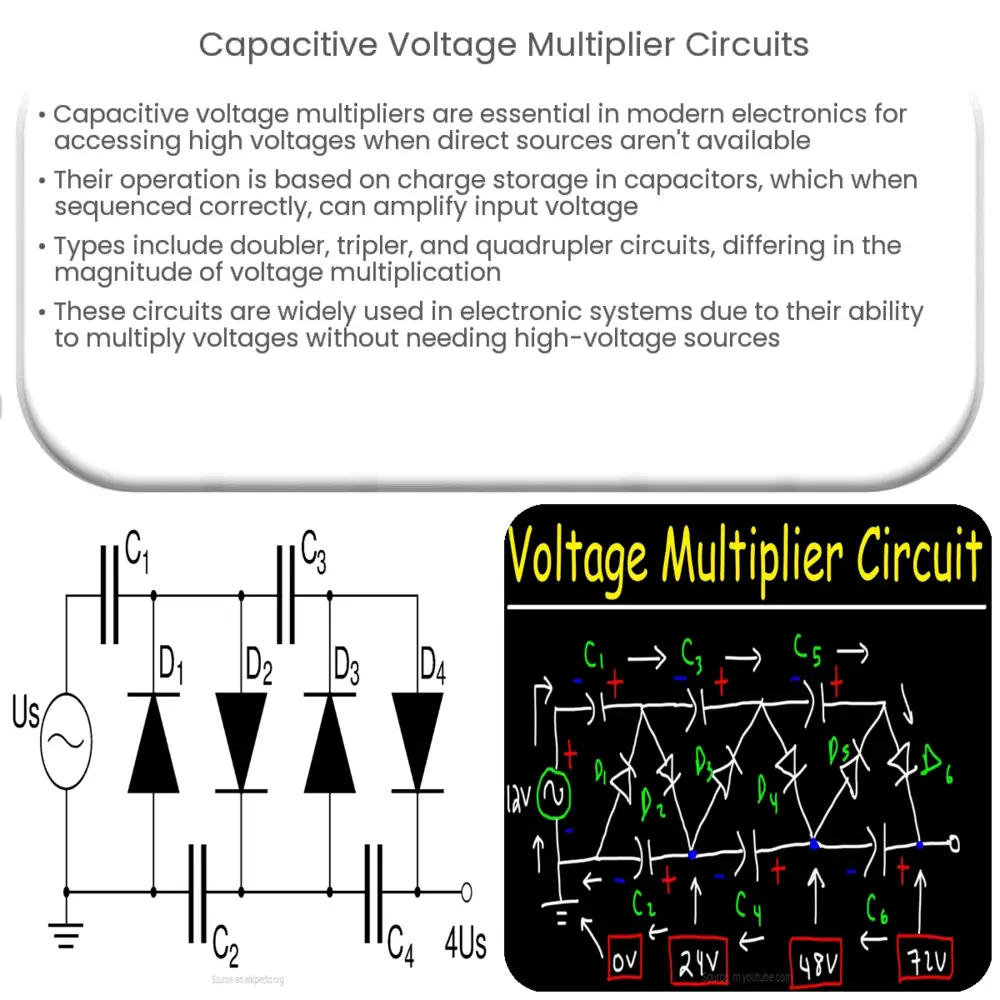Explore the fundamentals of capacitive voltage multiplier circuits, their working principles, types, applications, pros, and cons. Ideal for electronics enthusiasts.

Introduction to Capacitive Voltage Multiplier Circuits
Capacitive voltage multiplier circuits are an integral part of modern electronics, especially in applications where high voltages are required but direct access to high voltage sources is either impossible or inconvenient. These circuits function by effectively increasing the voltage that is available from an input source.
Working Principle of Capacitive Voltage Multipliers
The fundamental operation of a capacitive voltage multiplier revolves around the principle of charge storage in capacitors and their sequential discharge. They exploit the capability of capacitors to store energy in an electric field, thereby allowing voltages to be added together in a manner that can significantly increase the voltage output.
In a basic capacitive voltage multiplier, capacitors are charged in parallel during one half-cycle of the input AC voltage, effectively storing the voltage. During the other half-cycle, they are connected in series and therefore discharge in series. This results in an output voltage that is an integral multiple of the peak input voltage.
Types of Capacitive Voltage Multipliers
- Doubler Circuit: A voltage doubler circuit effectively doubles the peak voltage from the AC source. It consists of two capacitors and two diodes, connected in a specific manner to achieve this voltage doubling effect.
- Tripler Circuit: As the name implies, a voltage tripler circuit triples the peak AC voltage. It uses three diodes and three capacitors in a specific configuration to produce an output voltage that is three times the input voltage.
- Quadrupler Circuit: A voltage quadrupler circuit quadruples the peak AC voltage. It has a configuration of four diodes and four capacitors to generate an output voltage that is four times the peak input voltage.
Applications of Capacitive Voltage Multipliers
Due to their ability to multiply voltages without the need for a transformer or other high-voltage source, capacitive voltage multipliers find wide-ranging applications in electronic systems. They are commonly used in high-voltage power supplies, oscilloscope probes, TV sets, X-ray equipment, and some types of particle accelerators. However, one must be aware that these circuits are not suitable for driving heavy loads due to the presence of diodes and capacitors in the circuitry.
Advantages and Disadvantages of Capacitive Voltage Multipliers
Like any electronic circuit, capacitive voltage multipliers have both advantages and disadvantages. One significant advantage is their simplicity – they do not require complex circuitry or high-voltage sources. They are also compact, making them ideal for integration into small electronic devices.
Furthermore, they are relatively inexpensive to produce, as they primarily consist of diodes and capacitors, which are low-cost components. Also, capacitive voltage multipliers are useful in situations where isolation from the input source is desirable for safety reasons.
However, these circuits also have their drawbacks. The primary limitation is the power loss due to the diodes and capacitors used in the circuit. This leads to efficiency issues, especially when driving heavy loads. Additionally, the output voltage can fluctuate based on the load’s demand, which may not be desirable in some applications.
Understanding the Circuit Components
In capacitive voltage multiplier circuits, two main components are used: capacitors and diodes. Capacitors store and release electrical energy, while diodes ensure that current flows in one direction. Understanding how these components interact is crucial to grasping the operation of a capacitive voltage multiplier.
- Capacitors: In these circuits, capacitors act as energy storage devices. When the input voltage is applied, capacitors get charged, and during the other half cycle, they discharge, delivering their stored energy to the output.
- Diodes: Diodes, on the other hand, are unidirectional devices that control the direction of current flow. They prevent the discharging capacitors from sending current back to the input source, thereby ensuring that the accumulated voltage is delivered to the output.
Conclusion
In conclusion, capacitive voltage multiplier circuits are valuable tools in electronics, offering a practical way to multiply input voltages without the need for complex or high-voltage sources. Despite their limitations, they find widespread use in many applications where a higher voltage output is required from a lower voltage input source. As our electronics continue to evolve, understanding the principles and applications of these circuits is a worthwhile endeavor for anyone involved in electronic design and development.

